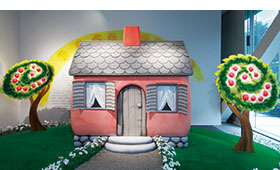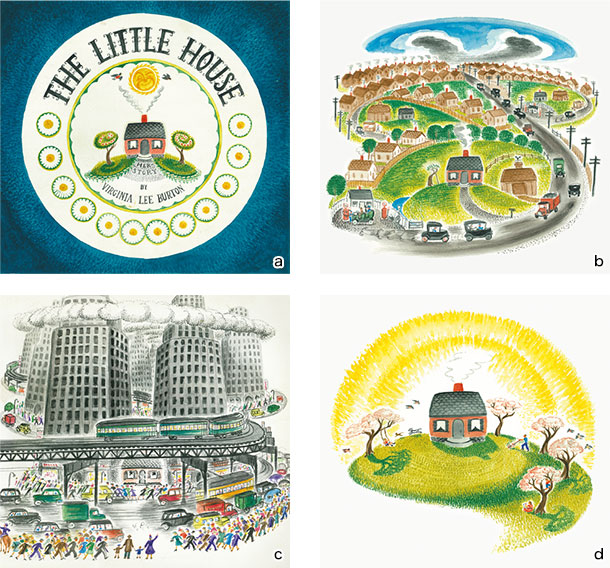『ちいさいおうち』(1942)

会場写真
田舎の丘に建つピンクの「ちいさいおうち」は、陽が昇り、陽が沈む丘、四季折々に花が咲き、小鳥が果実をついばむお庭、「おうち」に暮らす人々が子どもから大人に成長していく様子を見守り幸せな時を過ごしていました。しかし、時代が経ち開発が進むと「ちいさいおうち」の周りにも道路が出来、電車が通り、ビルが建つ大都会になります。
「ちいさいおうち」はビルの谷間に埋もれ、星空も見えなくなり悲しみにくれます。数年が過ぎ「ちいさいおうち」は、このお家を建てた家族の子孫に見つけられ、再び郊外の丘に曳き家され幸せを取り戻すという物語です。
この物語に描かれる田舎の風景や季節の移り変わりは、バートンの家の周りの自然そのものでした。彼女は、子ども達に世代を超えて繋がっていく時間のひろがりや、時は過ぎ、周囲は変わる大きな「時間」という概念をつたえようとしました。また、自然とその中での簡素な生活から遠ざかれば遠ざかるほど、不幸になってしまう、逆に自然と調和して生きることの素晴らしさを体感できるように描いたのです。
子どもに愛されたこの絵本は1943年にコルデコット賞を受賞します。彼女はその受賞スピーチで「太陽が昇り沈むことで1日を、月が満ちたりかけたりすることで1か月を、四季が移り変わることで1年が過ぎていくのを表現しました」と語っています。また絵の中に、マイクとメアリー・アンらしき姿を登場させたり、ブランコで遊ぶアリス(長男)や芝刈りをするジョージ(夫)、スケッチをするジニー(自分)の姿を描き、細部にも工夫を凝らします。それらの工夫は子ども達が身の回りの出来事と物語を対照させながら物語の中に入っていくよう導きます。彼女の絵本の主人公はいつも女性です。この「ちいさいおうち」に名前はありませんが、表紙の絵の入口に「her-story」と記されています。そのことは、「History」という歴史の概念は、男性だけが歴史を作る「his-story」なのではなく、女性もまた歴史の主人公だという彼女からのメッセージが記されているのです。

『ちいさいおうち』原画 制作年不明 紙、水彩
ミネソタ大学図書館カーランコレクション所蔵
a. 表紙 ©Aristides Burton Demetrios
b. 「街への変化」P16-17 ©Aristides Burton Demetrios
c. 「ビルに挟まれたおうち」P32-33 ©Aristides Burton Demetrios
d. 「再びの落ち着き」P38-39 ©Aristides Burton Demetrios
The Little House (1942)

Exhibition Photos
The pink “little house” standing on a hill spends happy days watching the hill where the sun rises and sets, the garden with seasonal flowers and little birds picking at fruits and the children living there growing to adults. Time passes and city development continues with roads constructed and trains running around “the little house”. The countryside has grown to a big city with skyscrapers.
“The little house” is buried in the forest of tall buildings, feeling sad that she can no longer see the starry sky at night. Several years later, a descendent of the family who built the house discovers “the little house” and moves her to the hill in the countryside where she can recover her happiness again.
The rural landscapes and changes of the seasons represented in the story are nothing but the nature around the Burton’s house. She tries to communicate children the long span of time across generations and the broad concept of time, which accommodates changes of environment. She created the story to show the the further people live away from simple life in nature, the less happy they become. She wrote the story so that children could feel the beauty of living in harmony with nature.
Children loved the picture book and the book was awarded with Caldecott Medal in 1943. In the award speech she said, “I expressed the passage of time of the day with the sun rising and setting, that of the month with waxing and waning of the moon and that of the year with seasons.” In the illustration of the book we can find Mike and Mary Anne, Aris (the older son) playing in a swing, George (husband) mowing the lawn and Jinnee (herself) sketching. She is very careful in the details so that the readers can be drawn into the story while comparing it with their familiar events. The main characters of her stories are always female. The “little house” has no name but the door to the house found in the cover of the book has a sign of “Her-Story”. It is her message that history is not composed only of his-story but also her-story and women have played a major role in history.

“The Little House” Original artwork Undated Watercolor on paper
Collection of the Kerlan Collection at University of Minnesota
a. Cover ©Aristides Burton Demetrios
b. ‘Urbanized’ P16-17 ©Aristides Burton Demetrios
c. ‘Building house & house’ P32-33 ©Aristides Burton Demetrios
d. ‘Relocated’ P38-39 ©Aristides Burton Demetrios